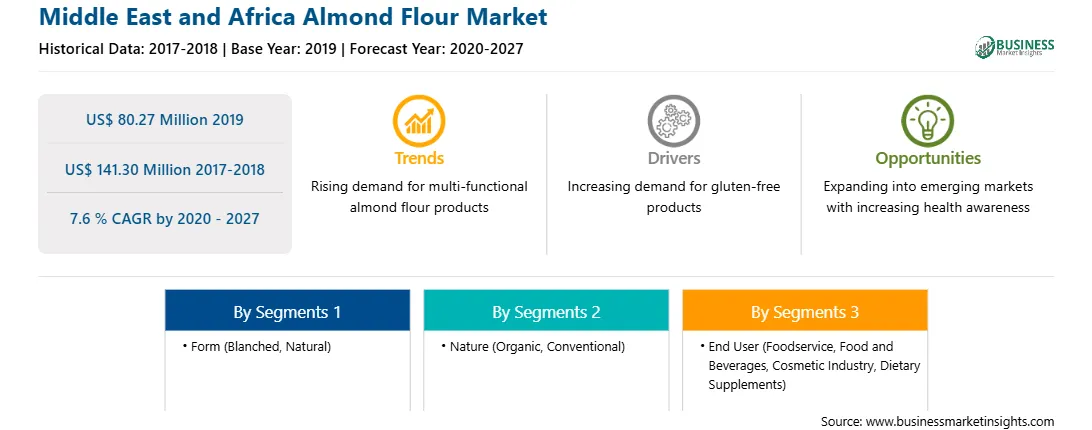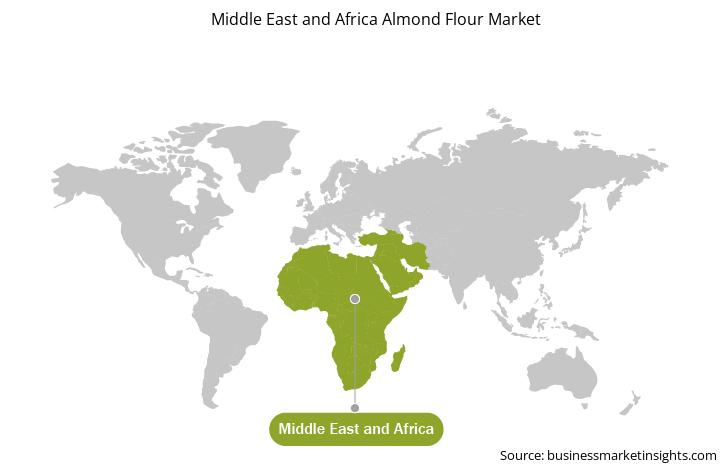The Middle East and Africa (MEA) almond flour market, by country, has been sub-segmented into South Africa, Saudi Arabia, the UAE, and the Rest of MEA. Middle East countries such as Kuwait, Saudi Arabia, and the UAE have experienced a shift in the socio-economic condition, food eating habits, lifestyle and economic status, and health patterns in the past four decades. These countries are known for their secure financial status. This shift has occurred due to the increase in income owing to accumulated oil revenues. The market in the Middle East and Africa is also experiencing rapid development with the growth of markets such as Iraq, Yemen, and Iran. Almond flour is estimated to have a growing opportunity in the Middle East and Africa region due to its rising demands from various end-use industries like residential, food processing, cosmetics, and from the HORECA sector.
Strategic insights for the Middle East and Africa Almond Flour provides data-driven analysis of the industry landscape, including current trends, key players, and regional nuances. These insights offer actionable recommendations, enabling readers to differentiate themselves from competitors by identifying untapped segments or developing unique value propositions. Leveraging data analytics, these insights help industry players anticipate the market shifts, whether investors, manufacturers, or other stakeholders. A future-oriented perspective is essential, helping stakeholders anticipate market shifts and position themselves for long-term success in this dynamic region. Ultimately, effective strategic insights empower readers to make informed decisions that drive profitability and achieve their business objectives within the market.

| Report Attribute | Details |
|---|---|
| Market size in 2019 | US$ 80.27 Million |
| Market Size by 2027 | US$ 141.30 Million |
| Global CAGR (2020 - 2027) | 7.6 % |
| Historical Data | 2017-2018 |
| Forecast period | 2020-2027 |
| Segments Covered |
By Form
|
| Regions and Countries Covered | Middle East and Africa
|
| Market leaders and key company profiles |
The geographic scope of the Middle East and Africa Almond Flour refers to the specific areas in which a business operates and competes. Understanding local distinctions, such as diverse consumer preferences (e.g., demand for specific plug types or battery backup durations), varying economic conditions, and regulatory environments, is crucial for tailoring strategies to specific markets. Businesses can expand their reach by identifying underserved areas or adapting their offerings to meet local demands. A clear market focus allows for more effective resource allocation, targeted marketing campaigns, and better positioning against local competitors, ultimately driving growth in those targeted areas.

The almond flour market in MEA is expected to grow from US$ 80.27 million in 2019 to US$ 141.30 million by 2027; it is estimated to grow at a CAGR of 7.6 % from 2020 to 2027. Almond flour refers to almond nuts that has been ground and sieved to a certain particle size. It is mainly made from blanched almonds that lacks the dark flecks of skin. It is the most widely used nut product and is often used to make premium pastries, cookies and sweet goods like almond macaroons. As the nuts are not ground to uniform sizes, the almond flour is sometimes coarser. It is sold in well stocked supermarkets, grocery stores as well as online. It can also be made at home. Almond flour has recently become famous and is used in baking items for consumers who prefer low-carbohydrate diets. It provides moisture and rich nutty taste to the baked goods. The items made using almond flour tend to be calorie- dense.
COVID 19 has impacted the major countries of MEA. Most of the countries in the region are under lockdown, which is impacting the almond flour market. Saudi Arabia has the highest number of confirmed cases of the COVID-19 infection among all MEA countries. This is likely to impact the food and beverages industry in the region, mainly due disrupted supply and distribution chains.
In terms of form, the blanched segment accounted for the largest share of the MEA almond flour market. In 2019 In terms of nature, conventional held the largest market share in 2019. In terms of end user, food and beverages sector accounted for the largest share of the MEA almond flour market.
A few major primary and secondary sources referred to for preparing this report on the MEA almond flour market are company websites, annual reports, financial reports, national government documents, and statistical database, among others. Major companies listed in the report are Shiloh Farms
MEA Almond flour Market, by Form
MEA Almond flour Market, by Nature
MEA Almond flour Market – by End User
MEA Almond flour Market – by Country
The Middle East and Africa Almond Flour Market is valued at US$ 80.27 Million in 2019, it is projected to reach US$ 141.30 Million by 2027.
As per our report Middle East and Africa Almond Flour Market, the market size is valued at US$ 80.27 Million in 2019, projecting it to reach US$ 141.30 Million by 2027. This translates to a CAGR of approximately 7.6 % during the forecast period.
The Middle East and Africa Almond Flour Market report typically cover these key segments-
The historic period, base year, and forecast period can vary slightly depending on the specific market research report. However, for the Middle East and Africa Almond Flour Market report:
The Middle East and Africa Almond Flour Market is populated by several key players, each contributing to its growth and innovation. Some of the major players include:
The Middle East and Africa Almond Flour Market report is valuable for diverse stakeholders, including:
Essentially, anyone involved in or considering involvement in the Middle East and Africa Almond Flour Market value chain can benefit from the information contained in a comprehensive market report.